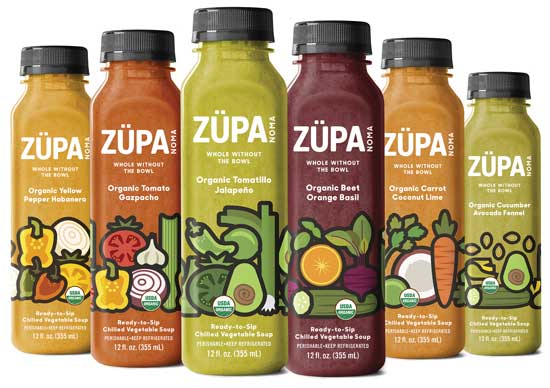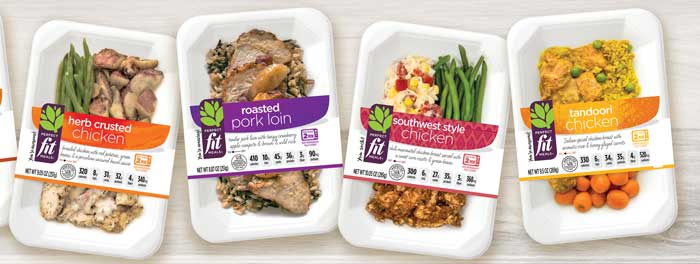Packaged to Preserve
PACKAGING
Extending shelf life is a primary function of food packaging, and new preservation technologies reduce nutrient, flavor, and color losses and degradative reactions during processing. As preservation technologies advance, packaging needs to meet new processing and product requirements. High pressure processing (HPP), microwave-assisted thermal sterilization (MATS), and active packaging present challenges and opportunities. A fresh-to-the-consumer look at retail is possible when innovative packaging is combined with new preservation technologies.
 Packaging for HPP
Packaging for HPP
HPP is used as a preservation technology for a wide range of products from applesauce and juices to deli meats and ready-to-eat meals. It is also used to increase cheese yield and facilitate the post-process use of the raw designation on shellfish and meats. While many package design and technical requirements are different for HPP and pressure-assisted thermal sterilization (PATS), some are the same. Unique HPP packaging requirements relate to the pressure differential as well as the decreased process temperature and time. HPP pressures vary from 150 MPa to 800 MPa with adiabatic compression heating increasing the product temperature by approximately 4°F per 100 MPa. HPP is commonly known as a cold pasteurization technique. PATS allows for higher temperatures to achieve sterilization under high pressure; however, it is not yet commercially available. For both HPP and PATS, foods and beverages are processed in flexible packages or packages with at least one flexible interface to transmit the pressure. Not surprisingly, packaging concerns (such as delamination, blistering, and decreased barrier properties) relate to the effects of the process pressure and temperature. A package with minimal or no headspace is usually suitable for the process. Otherwise, the excess headspace in the package may interfere with the uniform and efficient application of pressure.
 Hossein Daryaei, a research scientist at Illinois Institute of Technology’s Institute for Food Safety and Health, has worked with HPP and PATS for more than 12 years. “Compressibility of the headspace gas may result in packaging damages during pressurization, such as delamination in flexible packages with relatively large headspace volumes. This can be seen when HPP is combined with modified atmosphere packaging to further enhance the product safety and shelf life,” he says. “A fast and uncontrolled decompression may also lead to packaging problems such as microdefects and white spots on the surface of packaging films due to the rapid volume expansion of gasses, necessitating a controlled decompression rate to be applied when processing food in packages with large headspace gasses.” In addition to the integrity and barrier properties, other critical package parameters include elasticity, tensile, and seal strength to ensure that a package has the resiliency to withstand the volume change of HPP and PATS. The required package resiliency can be obtained using flexible lidding on a rigid container. Flexible, high-barrier polymer films are commonly used for HPP packaging. HPP may improve the barrier properties of polymer films to some extent by reducing the free volume of the polymer. “The packaging materials used for PATS should be able to withstand not only the high-pressure process but also the preheating step under atmospheric conditions without significantly losing their integrity and barrier properties,” Daryaei says. From a package design perspective, HPP and PATS can offer more flexibility than many other alternative food processes in which packaging materials may be exposed to temperature, radiation, and pressure extremes. The polypropylene-based tray containing an ethylene vinyl alcohol (EVOH) layer by Sealed Air, Charlotte, N.C. (sealedair.com), at Texas Food Solutions, Katy, Texas (texasfoodsolutions.com), is an example of what is possible in packages designed for HPP. Shelf-life requirements must be included in designing a suitable packaging system for HPP and PATS to ensure that the quality attributes of the product are maintained during storage.
Hossein Daryaei, a research scientist at Illinois Institute of Technology’s Institute for Food Safety and Health, has worked with HPP and PATS for more than 12 years. “Compressibility of the headspace gas may result in packaging damages during pressurization, such as delamination in flexible packages with relatively large headspace volumes. This can be seen when HPP is combined with modified atmosphere packaging to further enhance the product safety and shelf life,” he says. “A fast and uncontrolled decompression may also lead to packaging problems such as microdefects and white spots on the surface of packaging films due to the rapid volume expansion of gasses, necessitating a controlled decompression rate to be applied when processing food in packages with large headspace gasses.” In addition to the integrity and barrier properties, other critical package parameters include elasticity, tensile, and seal strength to ensure that a package has the resiliency to withstand the volume change of HPP and PATS. The required package resiliency can be obtained using flexible lidding on a rigid container. Flexible, high-barrier polymer films are commonly used for HPP packaging. HPP may improve the barrier properties of polymer films to some extent by reducing the free volume of the polymer. “The packaging materials used for PATS should be able to withstand not only the high-pressure process but also the preheating step under atmospheric conditions without significantly losing their integrity and barrier properties,” Daryaei says. From a package design perspective, HPP and PATS can offer more flexibility than many other alternative food processes in which packaging materials may be exposed to temperature, radiation, and pressure extremes. The polypropylene-based tray containing an ethylene vinyl alcohol (EVOH) layer by Sealed Air, Charlotte, N.C. (sealedair.com), at Texas Food Solutions, Katy, Texas (texasfoodsolutions.com), is an example of what is possible in packages designed for HPP. Shelf-life requirements must be included in designing a suitable packaging system for HPP and PATS to ensure that the quality attributes of the product are maintained during storage.
Mark Fleck, a consultant with Universal Pasteurization, Lincoln, Neb. (universalpasteurization.com), highlights another critical technical parameter: the oxygen-transmission-rate (OTR) barrier required. “Since HPP is designed to increase product shelf life, the package shelf life after HPP needs to be longer as well. This often means increased barrier properties, and we factor this into our package guidance. [An] OTR less than 6cc/day generally provide[s] adequate protection within the process. But lower OTR may be needed, depending on final shelf life,” Fleck explains. HPP affects the OTR of hydrophilic EVOH less than retort processing because of the lower process temperatures and time. Recent research suggests that HPP and PATS can increase the barrier properties of a package because of reduced free volume within the polymer. When it comes to assessing the impact of crystalline and amorphous regions within a polymer structure, more research is needed. Other areas needing more research are the use of antimicrobial packaging and the sorption and desorption characteristics of polymers in HPP. The Cold Pressure Council is developing an HPP verification system and a packaging seal, which will indicate that an independent third party has certified the food product inside the package as safe for human consumption.
Packaging for MAPS and MATS
MATS results in shelf-stable foods such as heat-sensitive dairy-based sauces, meat products, meals, and baby food. Examples of products treated with microwave-assisted pasteurization system (MAPS) include meat- and egg-based meals, vegetables, seafood, and shellfish. For MATS, packaged food is immersed in hot (255°F) water and microwaved at 915 MHz; for MAPS, packaged food is in water with a temperature range of 164°F–200°F and microwaved at 915 MHz. Developed at Washington State University with funding from the U.S. Army Natick Soldier Research, Development, and Engineering Center and the U.S. Dept. of Agriculture, MATS and MAPS need specialized barrier packaging for food subjected to these processes. Such packaging requires careful consideration of materials and package geometry. In terms of package materials, nonmetallized polymer films are most common, so polypropylene-based seal layers are commonly used.
“In collaboration with polymer companies Kuraray America Inc., Houston, Texas (kuraray.us.com); Toppan USA Inc., Griffin, Ga. (toppan-usa.com); Printpack Inc., Atlanta, Ga. (printpack.com); DNP, Tokyo, Japan (dnp.co.jp); Mitsubishi Gas and Chemical America, New York (mgc-a.com); and Shields Bags and Printing Company, Yakima, Wash. (shieldsbag.com), we are evaluating and developing barrier packaging for microwave-assisted thermal processing technologies,” says Shyam Sablani, associate professor at Washington State University and co-chair of the IFT Food Packaging Division. Such packaging incorporates barrier structures with polyethylene terephthalate bases with EVOH, aluminum oxide or silicone oxide coatings and the use of oxygen absorbers. However, researchers have determined that “changes in oxygen and water vapor transmission rates of multilayer films are much smaller after microwave processes compared to conventional/thermal retort processes of similar lethality,” Sablani says. This allows a longer shelf life versus traditional processing. Packaging for MATS and MAPS tends to be rectangular or oval-shaped semi-rigid polypropylene-EVOH trays with peelable lidding. “Interestingly, the unique and patented design of tray carriers within the processing environment allows for uniform heating of products in different compartments. This results in [the] ability for a single microwave process to be able to match the different thermal and dielectric properties of foods within multi-compartment trays,” Sablani says. Food science and packaging professionals receive training at Washington State University’s microwave technology boot camp.
Active Packaging
Modified atmosphere packaging has extended the shelf life of foods for many years. The use of the package headspace to control shelf life is now commonplace within the food industry. Packages filled with carbon dioxide and nitrogen increase the shelf life of a vast array of products, including clean label bakery products, meat, and produce. Polymer films stall spoilage by allowing gases to escape as temperature increases. Microperforations in packaging films are used to slow the respiration of produce while preventing anaerobic environments in packages for produce and minimally processed food.
Nowadays, desorption of compounds to inhibit microbial growth is an area of intense research within active packaging. For example, one application incorporates edible films containing antimicrobials that stall microbial growth in many products. In an effort to reduce food waste and nutrient loss during global distribution, research is also focusing on fruits and vegetables. Recently, the U.S. Army Natick Soldier Research, Development, and Engineering Center developed a packaging system to eliminate vegetative pathogens and bacterial spores and to inhibit mold growth on fresh fruits, vegetables, and berries. IFT Food Packaging Division co-chair Christopher Doona, a research scientist at the Natick Center who specializes in nonthermal processing and food safety, and a team of collaborators developed the technology, which utilizes chlorine dioxide. “The system uses common food packaging materials such as polylactic acid and hydrogels to generate sustained, low levels of disinfectant in [the] package. For its unique design and purpose, the invention is nicknamed CoD, an acronym for Compartment of Defense,” Doona says. The system can also be used as a plastic handheld spray bottle. Chlorine dioxide is commonly used as a biocide to treat drinking water and process water, to sanitize surfaces, and to wash fresh produce and inactivate surface microorganisms. In alternative methods, researchers are focusing on the production of gaseous chlorine dioxide in-package.
“With the CoD, humidity from respiring produce causes the sorption of water and triggers the release of chlorine dioxide at low sustained doses to enhance product safety, shelf life, and quality,” Doona says. Packaging considerations are that polymers such as polylactic acid, polypropylene, and nylon are less permeable to chlorine dioxide, and polystyrene and polyethylene have a low barrier to chlorine dioxide. The polymer permeability to oxygen and carbon dioxide changes over time based on the time of exposure to chlorine dioxide. The ratio of package headspace to product is critical in ensuring microbial inactivation. “The use of these polymers enables the controlled release of chlorine dioxide through unique redox chemistry without the use of acids, which is another key to the CoD technology,” Doona adds.
 Claire Koelsch Sand, PhD, Contributing Editor
Claire Koelsch Sand, PhD, Contributing Editor
President, Packaging Technology and Research
Adjunct Professor, Michigan State Univ.
[email protected]
